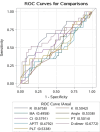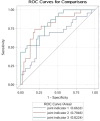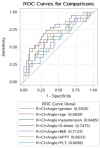Enhanced diagnostic capabilities of thromboelastography coupled with standard coagulation indices for predicting perioperative thrombosis in older individuals with hip fractures : TEG coupled with standard coagulation indices for predicting thrombosis in hip fractures
- PMID: 39719587
- PMCID: PMC11667881
- DOI: 10.1186/s13018-024-05386-4
Enhanced diagnostic capabilities of thromboelastography coupled with standard coagulation indices for predicting perioperative thrombosis in older individuals with hip fractures : TEG coupled with standard coagulation indices for predicting thrombosis in hip fractures
Abstract
Background: Deep venous thrombosis of the lower extremity is a common and fatal complication of hip fracture in the elderly. However, there is a lack of targeted laboratory diagnostic methods. Although traditional laboratory indicators can provide some reference, the diagnostic efficiency is relatively limited This study aimed to investigate the diagnostic accuracies of thromboelastography (TEG) combined with traditional coagulation parameters for early diagnosis of newly occurring lower extremity deep vein thrombosis (DVT) in elderly patients with hip fractures.
Methods: We conducted a retrospective cohort study including seventy-four elderly patients with hip fractures without lower extremity DVT at admission between 2022 and 2023. Disease history, laboratory tests including blood routine, six coagulation parameters at admission, and TEG on the day after the operation were collected using validated methods. Color Doppler ultrasonography of lower extremity venous was performed at admission and discharge to confirm the diagnosis of perioperative new thrombosis. A logistic regression model was used to construct joint diagnostic indexes using traditional parameters, including coagulation parameters and patient histories, combined with TEG indicators, and the receiver operating characteristic (ROC) curve was used to evaluate the discriminatory ability of each single TEG indicator and joint diagnostic indicators for newly occurring thrombosis in elderly patients with hip fracture.
Results: The incidence of lower extremity DVT was 33.78%. The average age was 82.0 years, and 7.0% were male. The TEG R values at discharge were 5.8 min and 6.3 min for the DVT and without VTE groups, respectively, showing a significant difference (p = 0.035). D-dimer levels in the DVT group were significantly higher than in the non-VTE group (4.3 vs. 2.9 mg/L, p = 0.029). The multivariate-adjusted model showed significant correlations between newly occurring DVT and TEG indicators, including R values, D-dimer, and BMI, with odd ratio values of 0.43, 1.43, and 1.25, respectively (all p value < 0.05). Among each traditional coagulation parameter and TEG indicators, D-dimer and R-value had the highest diagnostic accuracy (ROC area under the curve, AUC for D-dimer: 67.7%; AUC for R: 67.6%), respectively. For joint indicators, the combination of R + CI + αangle + D-dimer had the highest AUC (0.7475), followed by R + CI + αangle + BMI (0.7123). R + CI + αangle + gender had the lowest AUC (0.5920).
Conclusion: TEG demonstrates diagnostic value for newly occurring lower extremity DVT in elderly hip fracture patients. When combined with traditional coagulation parameters and patient histories, its diagnostic value is further enhanced, providing robust support for the establishment of a more comprehensive diagnostic and predictive scoring system for DVT in elderly hip fracture patients.
Keywords: Combination; DVT; Elderly patients; Hip fracture; TEG.
© 2024. The Author(s).
Conflict of interest statement
Declarations. Ethics approval and consent to participate: The study complied with all the relevant national regulations and institutional policies and was by the tenets of the Helsinki Declaration. It was approved by the ethical committee of China-Japan Friendship Hospital (ref. number: 2023-KY-145), and although the study was considered to have a minimal risk for patients since the blood samples for the TEG analysis were collected as part of routinely performed blood draws and no additional blood draws were performed, written consent was obtained from every patient. Competing interests: The authors declare no competing interests.
Figures



Similar articles
-
[Predictive value of combined examination of coagulation and fibrinolysis indexes for deep venous thrombosis after proximal femoral nail anti-rotation in elderly patients with femoral intertrochanteric fracture].Zhongguo Gu Shang. 2025 Apr 25;38(4):371-7. doi: 10.12200/j.issn.1003-0034.20231098. Zhongguo Gu Shang. 2025. PMID: 40296598 Chinese.
-
Admission prevalence of deep vein thrombosis in elderly Chinese patients with hip fracture and a new predictor based on risk factors for thrombosis screening.BMC Musculoskelet Disord. 2018 Dec 20;19(1):444. doi: 10.1186/s12891-018-2371-5. BMC Musculoskelet Disord. 2018. PMID: 30572863 Free PMC article.
-
Risk factor analysis and nomogram model of DVT in hip fracture patients at hospital admission.BMC Musculoskelet Disord. 2025 Feb 25;26(1):189. doi: 10.1186/s12891-025-08308-5. BMC Musculoskelet Disord. 2025. PMID: 40001010 Free PMC article.
-
Perioperative Focused Transthoracic Echocardiogram Evaluations for Elderly Hip Fractures: A Narrative Review of Literature and Recommendations.A A Pract. 2025 Mar 18;19(3):e01944. doi: 10.1213/XAA.0000000000001944. eCollection 2025 Mar 1. A A Pract. 2025. PMID: 40099817 Review.
-
The true treatment benefit is unpredictable in clinical trials using surrogate outcome measured with diagnostic tests.J Clin Epidemiol. 2005 Oct;58(10):1042-51. doi: 10.1016/j.jclinepi.2005.02.024. J Clin Epidemiol. 2005. PMID: 16168350 Free PMC article. Review.
References
-
- Lasocki S, Capdevila X, Vielle B, Bijok B, Lahlou-Casulli M, Collange V, Grillot N, Danguy des Deserts M, Duchalais A, Delannoy B, Drugeon B, Bouzat P, David JS, Rony L, Loupec T, Leger M, Rineau E, Hi FITI, network Sr. Ferric derisomaltose and tranexamic acid, combined or alone, for reducing blood transfusion in patients with hip fracture (the hifit trial): A multicentre, 2 x 2 factorial, randomised, double-blind, controlled trial. Lancet Haematol. 2023;10:e747–55. - PubMed
-
- Miyamoto RG, Kaplan KM, Levine BR, Egol KA, Zuckerman JD. Surgical management of hip fractures: an evidence-based review of the literature. I: femoral neck fractures. J Am Acad Orthop Surg. 2008;16:596–607. - PubMed
-
- Meng H, Zhu Y, Zhang J, Li J, Zhao K, Zhang Y, Chen W. Incidence and risk factor for preoperative deep vein thrombosis (dvt) in isolated calcaneal fracture, a prospective cohort study. Foot Ankle Surg. 2021;27:510–4. - PubMed
-
- Sun Y, Chen D, Xu Z, Shi D, Dai J, Qin J, Jiang Q. Incidence of symptomatic and asymptomatic venous thromboembolism after elective knee arthroscopic surgery: a retrospective study with routinely applied venography. Arthroscopy. 2014;30:818–22. - PubMed
MeSH terms
Grants and funding
LinkOut - more resources
Full Text Sources
Medical

